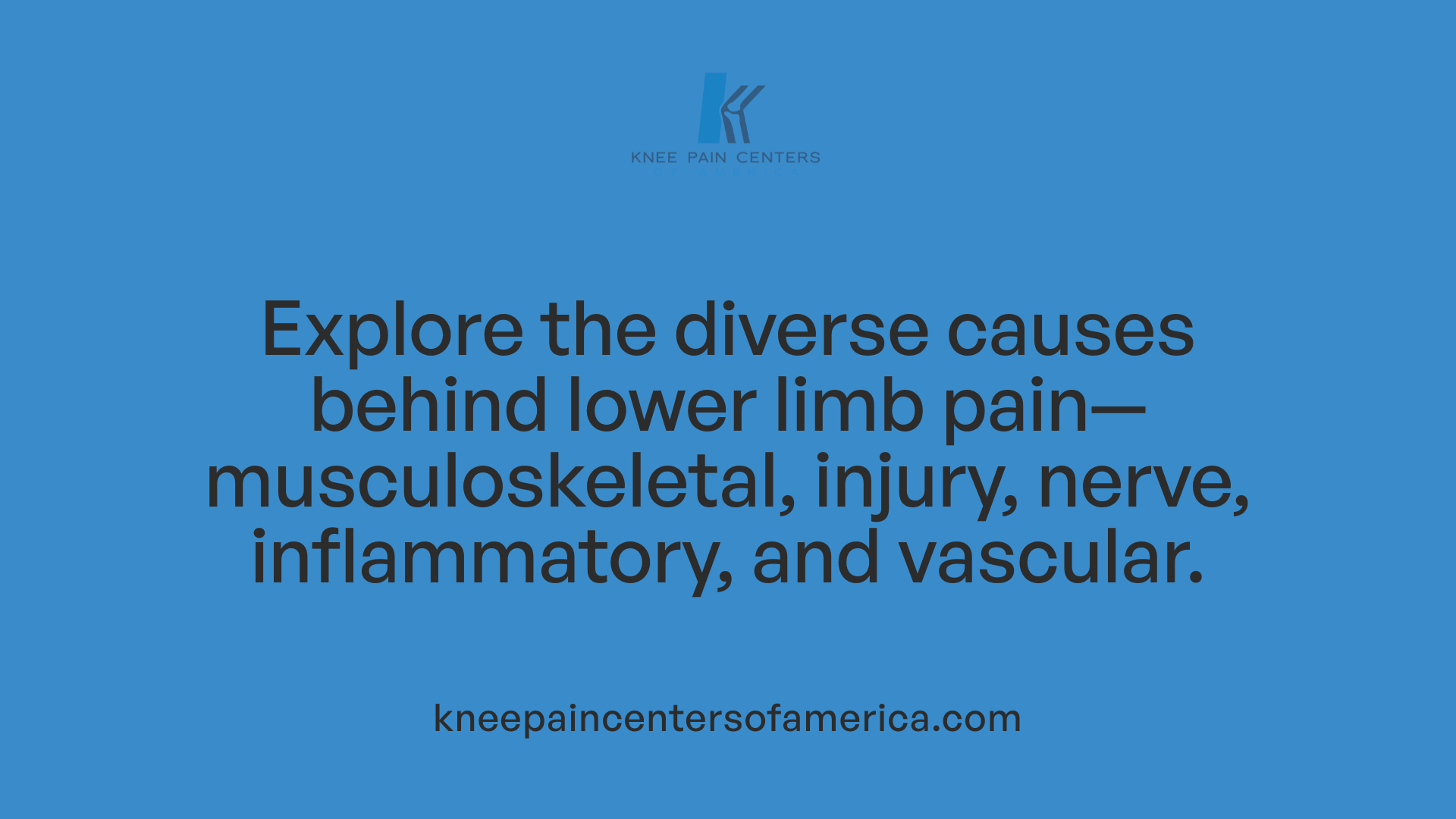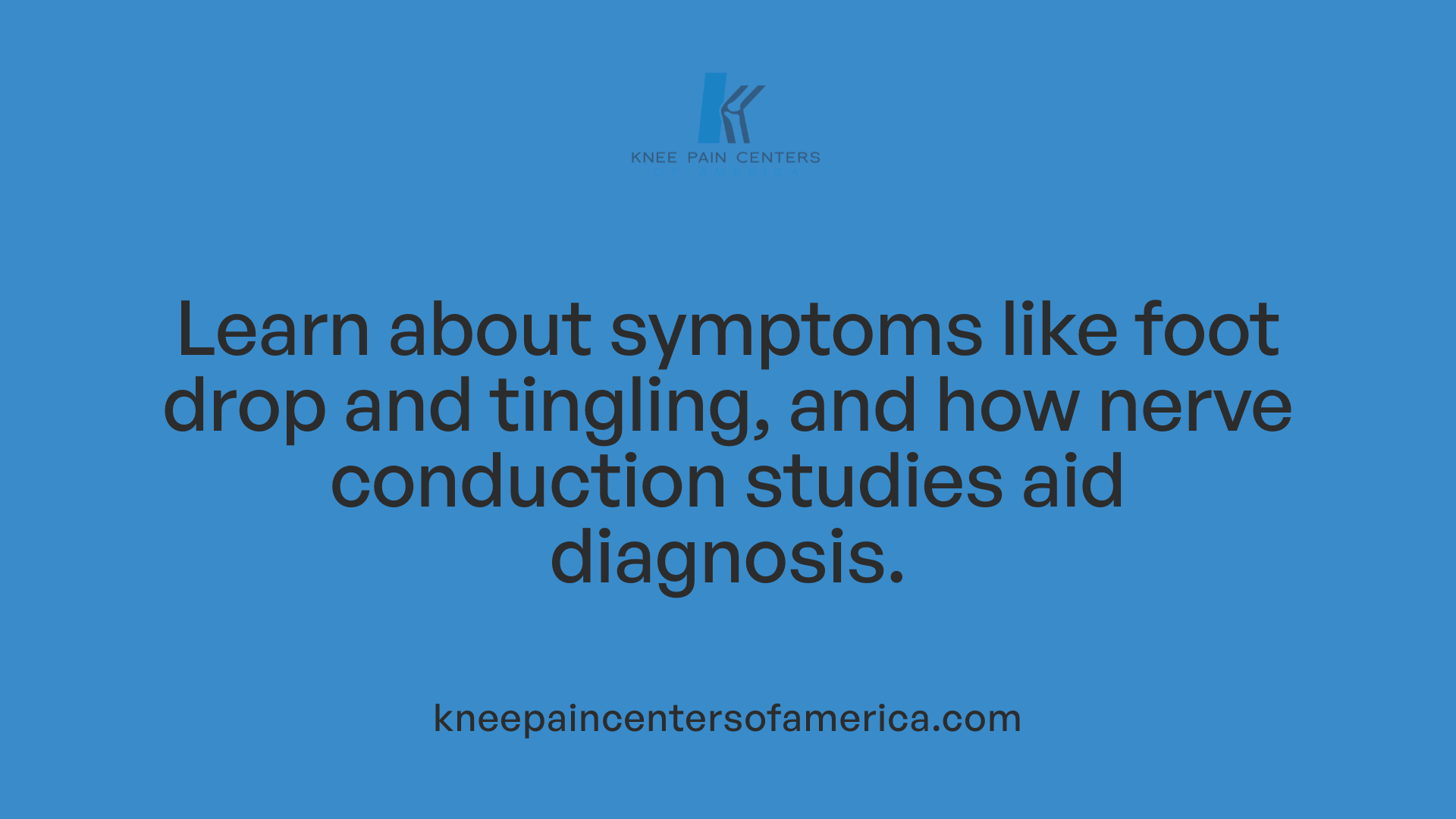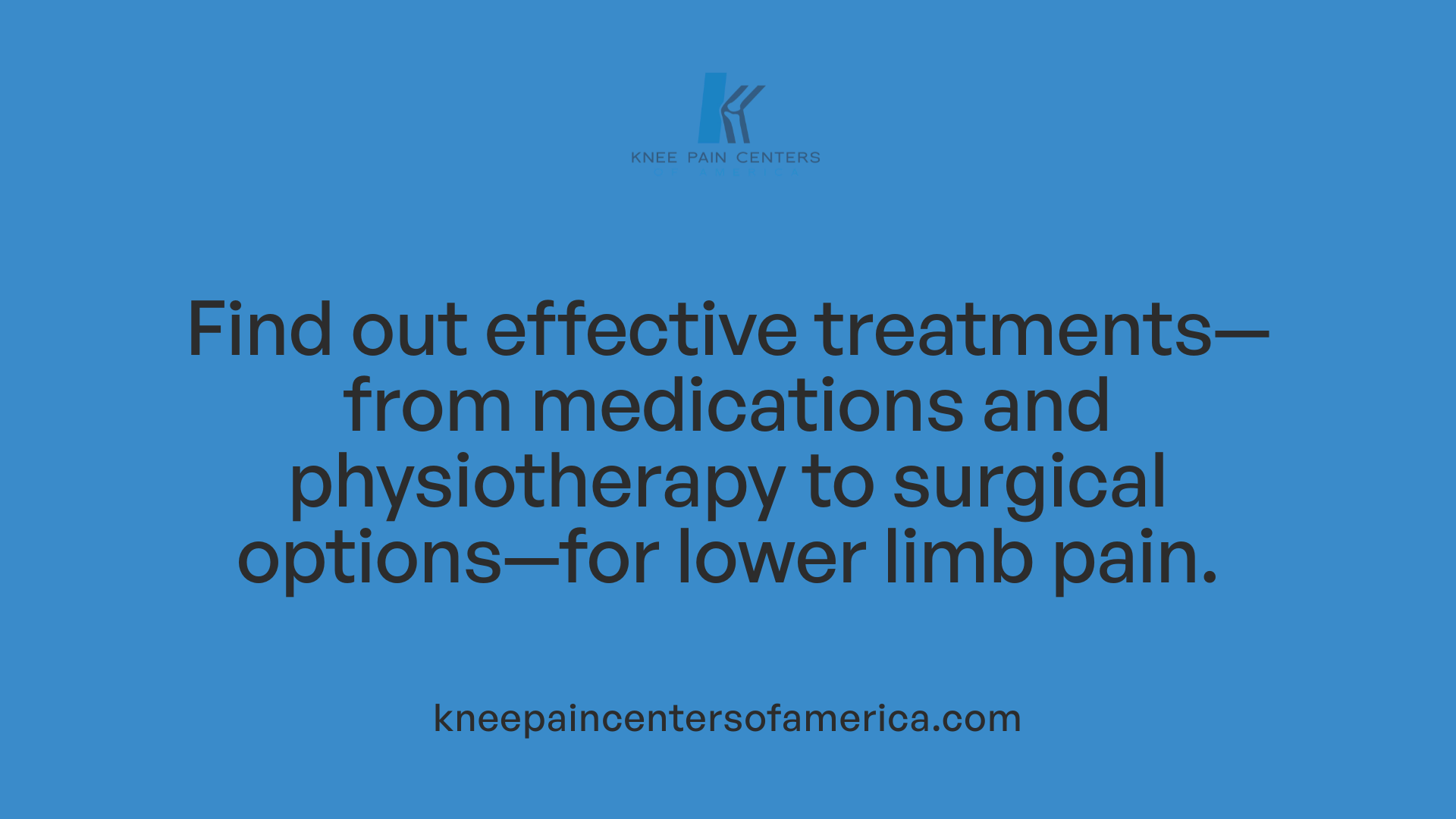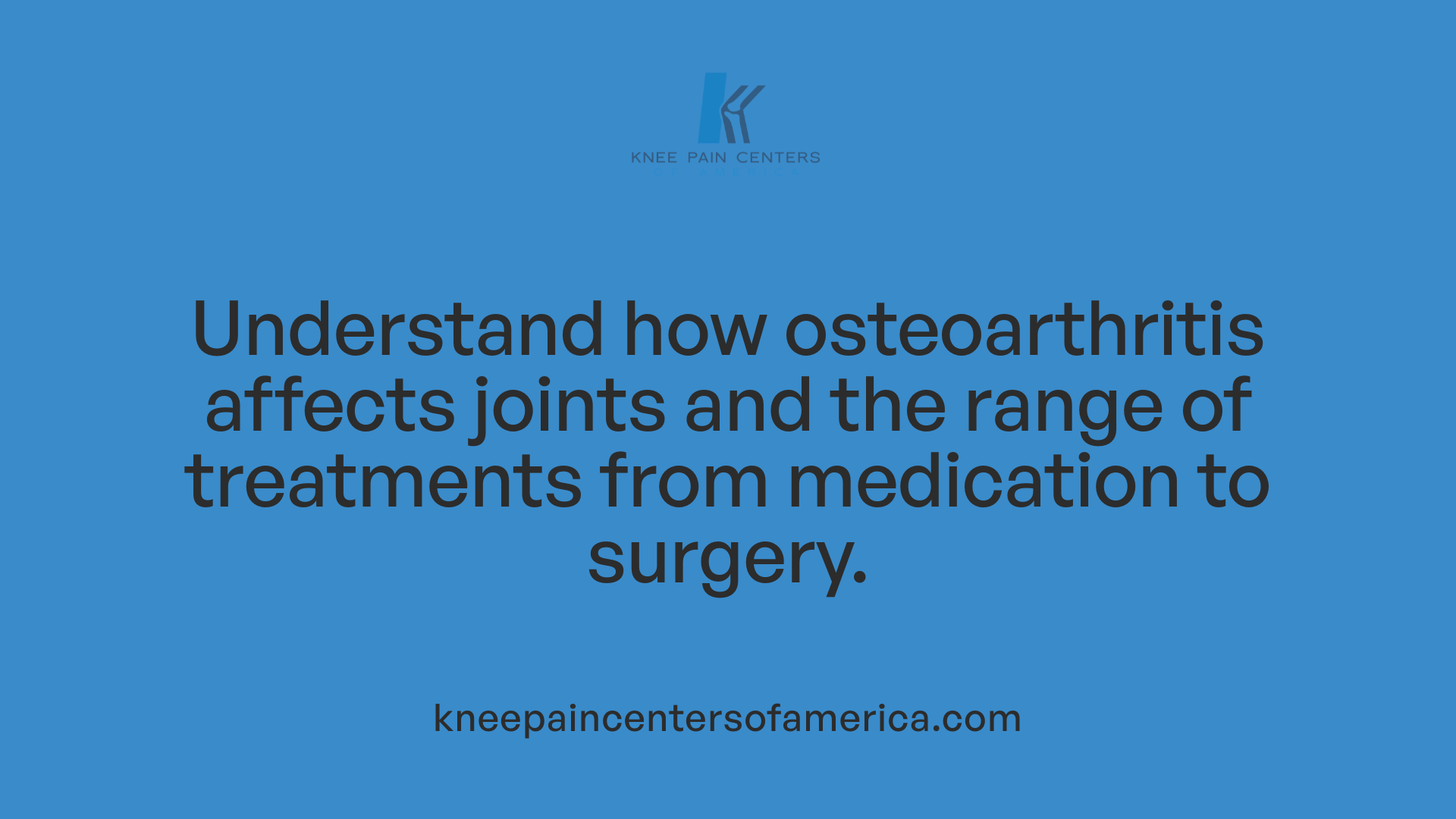An In-Depth Exploration of Causes, Symptoms, and Treatments
Pain from the knee to the foot encompasses a broad spectrum of conditions, each with unique causes, symptoms, and management strategies. Recognizing these differences is essential for effective diagnosis and treatment, ultimately improving patient mobility and quality of life. This article explores the anatomical, physiological, and systemic factors contributing to lower limb pain, focusing on common conditions such as osteoarthritis, nerve injuries, vascular issues, and deformities, while emphasizing the significance of early detection and tailored interventions.
Common Causes of Pain in the Knee, Ankle, and Foot

What are the common causes of lower limb pain, including the knee, ankle, and foot?
Pain in the lower limbs—covering the knee, ankle, and foot—can stem from a variety of health issues, including musculoskeletal problems, injuries, nerve damage, inflammatory disorders, and vascular conditions.
Musculoskeletal conditions are frequent culprits, such as osteoarthritis, which causes joint stiffness, swelling, and pain in the knees and ankles. Tendinitis, bursitis, and inflammation of the plantar fascia (plantar fasciitis) also contribute to foot and ankle discomfort. Additionally, deformities like bunions, hammer toes, and flat or high-arched feet can alter gait and stress joints, leading to pain.
Traumatic injuries often cause acute pain. Ligament tears, meniscal injuries in the knee, fractures, sprains, and strains from falls or sudden impacts are very common. These injuries tend to present with localized tenderness, swelling, and possible difficulty in movement.
Nerve-related issues can also produce pain and radiating sensations. Conditions like sciatica—caused by nerve compression in the lower back—or nerve injuries due to trauma may lead to burning, tingling, or numbness that travels down the leg, contributing to the pain experienced in the knee or foot.
Systemic and inflammatory conditions such as gout, rheumatoid arthritis, and other autoimmune diseases frequently affect multiple joints, including the knees, ankles, and feet. Gout, in particular, causes sudden, intense pain, swelling, and redness, often in the big toe or ankle.
Vascular problems, notably peripheral artery disease (PAD), are less common but significant causes. PAD causes restricted blood flow, resulting in cramping, fatigue, and pain during exertion, and can lead to coldness or discoloration of the limbs.
Proper diagnosis involves comprehensive physical exams, imaging tests—such as X-rays, MRI, CT scans, ultrasound—and sometimes nerve conduction studies. Identifying the precise cause guides appropriate treatment.
Treatment options vary widely depending on the diagnosis. They may include medications to manage inflammation and pain, physiotherapy to improve joint function, orthotic devices, injections, or surgical procedures when necessary.
Most importantly, timely medical attention helps prevent further joint deterioration and promotes recovery.
| Cause Category |
Specific Conditions |
Diagnostic Tools |
Treatment Approaches |
| Musculoskeletal |
Osteoarthritis, tendinitis, bursitis, deformities |
X-ray, MRI, physical exam |
Medication, physical therapy, orthotics, surgery |
| Traumatic injuries |
Ligament tears, fractures, meniscal injuries |
Ultrasound, MRI, X-ray |
Rest, immobilization, surgery |
| Nerve issues |
Sciatica, nerve injuries |
Nerve conduction studies, MRI |
Physical therapy, nerve decompression |
| Inflammatory and systemic |
Gout, rheumatoid arthritis |
Blood tests, joint aspiration |
Anti-inflammatory medication, disease-modifying agents |
| Vascular |
Peripheral artery disease (PAD) |
Doppler ultrasound, angiography |
Lifestyle changes, medications, surgery |
Understanding the interconnected nature of these causes is vital, as issues like abnormal foot posture or biomechanical imbalances can exacerbate knee or ankle pain. Regular check-ups and early intervention improve long-term outcomes.
Symptoms and Diagnosis of Lower Limb Nerve Injuries

What are the typical symptoms associated with nerve injuries in the lower limb, such as peroneal nerve injury?
Nerve injuries in the lower limb, particularly affecting the peroneal nerve, often present with specific symptoms that help in diagnosis. One of the most distinctive signs is foot drop, where the individual finds it difficult or impossible to lift the front part of the foot. This occurs because the nerve damage impairs muscle function responsible for dorsiflexion and toe extension.
Patients frequently experience numbness, tingling, or burning sensations along the top of the foot, outer calf, or shin—areas governed by the affected nerve. Motor impairments may lead to weakness in lifting the foot or toes, causing gait abnormalities such as a slapping or high-stepping walk. Sensory loss can also be localized, diminishing sensation in certain patches of the lower leg and dorsum of the foot.
These symptoms typically develop after traumatic events like ankle or knee fractures, dislocations, or surgeries. Nerve compression from tight footwear, casts, or prolonged pressure on the nerve can also cause similar issues. Occasionally, tumors or other growths pressing on the nerve can lead to nerve injury.
Nerve injury causes
Common causes include traumatic injuries, such as fractures or dislocations, especially around the ankle or knee, which can directly damage the nerve. Compression from cast immobilization, prolonged crossing of the legs, or tight footwear may also cause nerve impingement. Some cases stem from blood clots or tumors pressing on nerve pathways. Repetitive stress or nerve entrapment syndromes also contribute.
Diagnostic procedures
Diagnosing a nerve injury involves a combination of physical exams and specialized tests. A healthcare provider will examine motor function, check for muscle weakness, muscle wasting, and assess sensation. To confirm nerve damage, nerve conduction studies and electromyography (EMG) are essential. These tests measure electrical activity in muscles and the speed of nerve signals, helping determine if the nerve is injured or damaged.
Imaging techniques such as MRI, CT scans, and ultrasound aid in visualizing the nerve’s surroundings and identifying any compressive lesions, tumors, or structural abnormalities. Sometimes, neurography and advanced nerve conduction studies are performed for detailed mapping.
The treatment approach depends on the injury’s severity and cause. Mild cases may improve with conservative measures such as physical therapy, bracing, and relieving pressure. More severe injuries might require surgical intervention, including nerve decompression or repair.
Further resources
For a detailed search on how to diagnose peroneal nerve injury, consult medical resources and specialists in neurology or orthopedics who can provide tailored assessment and treatment options.
Diagnostic Methods for Lower Limb Pain Evaluation

What diagnostic approaches are used to evaluate pain in the lower limb?
Assessing lower limb pain involves a multifaceted approach, combining detailed history taking, physical examination, imaging, nerve testing, and vascular assessments. Each method provides crucial information to pinpoint the underlying cause of pain, facilitating targeted treatment.
The starting point is a thorough history, where healthcare providers ask about the onset, duration, location, and nature of the pain. They also inquire about recent injuries, activity levels, footwear habits, supporting medical conditions like arthritis or diabetes, and any associated symptoms such as numbness, tingling, or swelling.
Following history collection, a physical examination assesses joint stability, muscle strength, range of motion, and observes for signs of inflammation or deformity. The clinician evaluates gait and alignment as well.
Imaging studies are vital in visualizing structural problems. Bone and joint issues are identified through X-rays, which reveal fractures, joint space narrowing, or osteophytes. MRI provides detailed images of soft tissues, including ligaments, tendons, muscles, and cartilage, essential for detecting tears or inflammation.
Ultrasound is useful for dynamic assessment of tendons and bursae, especially in cases of tendinitis or bursitis. MR neurography extends traditional MRI to visualize nerves, assisting in diagnosing nerve entrapments or injuries.
Electrophysiological tests are key when nerve damage is suspected. Nerve conduction studies measure electrical activity along peripheral nerves, determining the location and extent of nerve damage. Electromyography evaluates muscle response and can differentiate nerve injuries from muscular disorders.
Vascular assessments help identify blood flow deficiencies contributing to pain or cramping. The ankle-brachial index (ABI) compares blood pressure in the ankle with the arm to detect peripheral arterial disease. Additional tests include exercise-induced blood flow measurements and vascular imaging such as Doppler ultrasound or angiography.
In some cases, diagnostic nerve blocks are employed to localize nerve source of pain, while compartment pressure measurements are used if compartment syndrome is suspected.
| Diagnostic Method |
Purpose |
Additional Details |
| History & Physical Exam |
Initial assessment of symptoms and signs |
Guides further testing |
| X-ray |
Bone and joint abnormalities |
Quick, widely available |
| MRI |
Soft tissue injuries, nerves |
Detailed imaging of complex tissues |
| Ultrasound |
Tendons, bursae, dynamic assessments |
Cost-effective, bedside option |
| MR Neurography |
Nerve visualization |
Precise nerve injury localization |
| Nerve Conduction & EMG |
Nerve and muscle function testing |
Differentiates nerve vs. muscular issues |
| Vascular Tests |
Blood flow evaluation |
Includes ABI, Doppler ultrasound |
In conclusion, a combination of these diagnostic techniques allows healthcare professionals to accurately identify the cause of lower limb pain, enabling effective and personalized treatment plans. Proper diagnosis is essential to prevent long-term disability and improve quality of life.
This comprehensive evaluation process underscores that diagnosing lower limb pain often requires an integrated approach, considering both musculoskeletal and neurovascular factors, to achieve the best patient outcomes.
Management Strategies for Lower Limb Pain

What treatment options are available for managing pain in the lower limb?
Lower limb pain can arise from a variety of causes, including musculoskeletal, neurological, vascular, or inflammatory conditions. The appropriate treatment approach depends on the specific diagnosis, severity, and duration of symptoms.
For mild discomfort, initial strategies often involve conservative measures. Rest is important to prevent further injury, while ice applications help reduce inflammation and swelling. Compression with elastic wraps and elevation of the limb can also alleviate symptoms. Over-the-counter pain relievers such as nonsteroidal anti-inflammatory drugs (NSAIDs) or acetaminophen are commonly used to manage pain.
Incorporating physical therapy is a fundamental component of treatment. Tailored exercises focus on restoring strength, flexibility, and joint stability, which can significantly reduce pain and improve function. Activities like stretching, strengthening of hip, knee, and ankle muscles, and gait training can help correct biomechanical issues contributing to pain.
Lifestyle modifications complement medical treatments. Maintaining adequate hydration, adopting a balanced diet, and wearing supportive footwear can prevent strain on the lower limbs. For those with structural deformities or persistent pain, custom orthotics or shoe inserts can optimize foot positioning and improve overall alignment.
When conservative treatments are insufficient, other interventions may be considered. Injections such as corticosteroids can provide targeted relief for inflammation. Minimally invasive procedures like nerve blocks might be used for specific nerve-related pain. Surgical options, including joint repair, removal of damaged tissue, or joint replacement, are reserved for severe or unresponsive cases.
Addressing systemic and vascular causes is equally important. Conditions like Peripheral Artery Disease (PAD) require specific treatments such as medications to improve blood flow or surgeries to bypass blocked arteries. Nerve compression syndromes, like sciatica stemming from lumbar disc herniation, are managed with physical therapy, medications, or, in some cases, surgical decompression.
In cases of blood clots, such as Deep Vein Thrombosis (DVT), prompt anticoagulation therapy is critical for preventing complications. Identifying and managing systemic illnesses like rheumatoid arthritis or autoimmune inflammatory arthritis can help control joint inflammation and reduce associated pain.
Overall, an integrated approach combining conservative management, targeted interventions, and addressing underlying systemic issues offers the best outcomes. Early diagnosis and treatment are crucial to avoiding long-term damage and improving quality of life.
| Treatment Option |
Description |
Suitable For |
| Rest and Ice |
Reduce activity, apply ice packs |
Mild, acute injuries |
| Medications |
NSAIDs, acetaminophen |
General pain relief |
| Physical Therapy |
Exercises to restore strength and flexibility |
Chronic pain, injuries |
| Orthotics and Supportive Footwear |
Shoe inserts, custom orthotics |
Structural issues, alignment |
| Injections |
Corticosteroids, nerve blocks |
Inflammation, persistent pain |
| Surgical Procedures |
Joint replacements, tissue removal |
Severe or unresponsive cases |
| Vascular Treatments |
Medication, surgery for blood flow issues |
PAD, ischemic conditions |
| Systemic Disease Management |
Disease-specific therapies |
Rheumatoid arthritis, autoimmune conditions |
Proper management involves a comprehensive assessment by healthcare professionals, including physical examinations and diagnostic tests like X-rays, MRI, ultrasound, or blood tests. This ensures that treatment is tailored to address each patient's unique condition effectively.
Impact of Arthritic Conditions on the Knee and Foot and Management Approaches

How do conditions like osteoarthritis affect the knee and foot, and what are the management strategies?
Osteoarthritis is a common degenerative joint disease that affects various joints, including the knees and ankles. When osteoarthritis develops in these joints, the cartilage that cushions the bones gradually wears away. This process results in bones rubbing against each other, which causes pain, swelling, stiffness, and sometimes decreased mobility. The pain may worsen with activity and improve with rest, and over time, joint deformities can occur. Many individuals experience a reduction in their ability to perform daily activities or exercise comfortably.
In the feet, osteoarthritis often affects the big toe and the midfoot, leading to discomfort and difficulty walking. The strain on neighboring joints and altered gait mechanics can also contribute to secondary problems, including misalignment and further joint degeneration.
Diagnosis Methods
Diagnosing osteoarthritis involves a combination of clinical evaluation and imaging techniques. Healthcare professionals conduct a physical examination to check for swelling, tenderness, range of motion, and joint deformity. Imaging tests such as X-rays are crucial, revealing joint space narrowing, bone spurs, and other structural changes characteristic of osteoarthritis. MRI scans offer detailed images of soft tissues and cartilage, helping to assess the severity of joint damage in complex cases. Additionally, laboratory tests may be performed to exclude other inflammatory conditions like rheumatoid arthritis.
Therapeutic Strategies
Managing osteoarthritis focuses on relieving pain, reducing inflammation, and maintaining joint function. Common treatments include:
- Medications: Non-steroidal anti-inflammatory drugs (NSAIDs) and acetaminophen are the mainstay for relieving pain. In some cases, topical agents like capsaicin are used.
- Physical Therapy: Tailored exercise programs improve joint flexibility, strengthen muscles surrounding the joint, and reduce stiffness. Weight loss is emphasized, especially for knee osteoarthritis, as it decreases stress on weight-bearing joints.
- Supportive Devices: Braces, shoe inserts, and orthotics help correct abnormal gait and distribute forces evenly across the joint, easing pain.
- Lifestyle Modifications: Using heat or cold therapy can help manage symptoms. Complementary treatments such as acupuncture have also shown benefits for some patients.
- Injections: Corticosteroid or hyaluronic acid injections can provide temporary relief of symptoms by reducing inflammation and lubricating the joint.
Surgical Options
When conservative treatments fail to provide adequate relief, surgical interventions become necessary. Common surgical options include:
| Procedure |
Purpose |
Details |
| Arthroscopic Surgery |
To remove bone spurs or debris |
Less invasive, for joint cleanup |
| Osteotomy |
To realign the joint |
Alters bone position to reduce stress |
| Joint Replacement |
To replace damaged joint |
Knee and ankle replacements are common |
| Joint Fusion |
To stabilize joints |
Minimizes pain but reduces mobility |
These procedures aim to reduce pain, improve function, and prevent further joint deterioration.
Additional Prevention and Management Tips
Preventing the progression of osteoarthritis involves maintaining a healthy body weight, staying active, and avoiding repetitive joint overload. Proper footwear and orthotics can support alignment and reduce joint stress. Early diagnosis and treatment are crucial for minimizing long-term damage.
Resources for Further Information
For more in-depth guidance on managing osteoarthritis in the knee and foot, consult healthcare providers specializing in musculoskeletal disorders. The search query “osteoarthritis knee and foot management” can lead to reputable sources offering detailed plans tailored to individual needs.
Role of Anatomy and Physiology in Lower Limb Pain
What role do anatomical and physiological factors play in lower limb pain?
Lower limb pain is shaped by a complex interplay of anatomical structures and physiological processes. These factors influence how pain develops, where it is felt, and its persistence.
From an anatomical perspective, bones, muscles, joints, nerves, and blood vessels create the framework and pathways for movement and stability in the lower limbs. For instance, abnormal foot postures like flat feet or high arches alter natural biomechanics, often overloading specific joints such as the knees and ankles. These structural issues can lead to inflammation, degeneration, or injury, which in turn causes pain.
Joint alignment and bone integrity are fundamental. Misalignments like a knocked-knee or bowleg can shift force distribution during walking, leading to excessive stress on certain tissues. Muscles and tendons provide support and control movement, but imbalances or weaknesses here can alter gait mechanics, increasing joint strain.
Nerves also play a vital role. Conditions like nerve compression from lumbar disc herniation or spinal stenosis affect how signals are transmitted, often resulting in radiating pain or numbness down the leg—a condition commonly known as sciatica. Peripheral nerves, such as the peroneal nerve, when injured, can cause foot drop and sensory disturbances, worsening overall lower limb discomfort.
Physiologically, processes like inflammation and tissue degeneration significantly contribute to pain. When tissues sustain injury or are subjected to excessive stress, nociceptors—specialized nerve endings—detect these changes and send pain signals to the brain. Inflammatory responses involve the release of chemical mediators that sensitize nociceptors, intensifying pain sensations.
Degenerative conditions such as osteoarthritis involve cartilage breakdown and joint inflammation, which further activate nociceptors and perpetuate pain. Similarly, nerve entrapments and impingements alter sensory transmission, often leading to chronic pain states.
Alterations in physiological functions like blood flow also impact pain experiences. Peripheral Artery Disease (PAD), for example, reduces blood flow to the lower limbs, causing cramping and fatigue. In cases of deep vein thrombosis (DVT), blood clots cause swelling, warmth, and tenderness, highlighting the importance of vascular health.
Moreover, systemic conditions like diabetes can lead to peripheral neuropathy—a nerve damage that causes burning, tingling, and numbness in the lower limbs.
The interaction between anatomical features and physiological reactions shapes every aspect of lower limb pain, including its location, intensity, and duration. Recognizing these factors is fundamental in diagnosing specific conditions and tailoring effective treatments.
How does this understanding influence clinical approaches?
Understanding the anatomy and physiology allows healthcare providers to identify the root causes of lower limb pain more accurately. Treatment strategies—whether physical therapy to correct biomechanics, medications to reduce inflammation, or surgical interventions—are chosen based on these insights. Moreover, patient education about the importance of gait, footwear, and activity management can prevent further injury.
Early detection of structural or physiological issues can halt disease progression and improve outcomes. In imaging diagnostics like X-rays, MRI, or ultrasound, recognizing structural abnormalities and physiological changes guides comprehensive management.
To summarize, the anatomy and physiology of the lower limb are central to why pain occurs and how it can be effectively treated. By understanding how these factors interact, clinicians can develop holistic, tailored interventions that address the specific needs of each patient.
Implications of Lower Limb Pain on Mobility and Well-being
What are the implications of lower limb pain on mobility and quality of life?
Lower limb pain significantly affects a person’s ability to move freely and perform daily activities. When leg muscles or joints are painful, gait speed often slows down, making walking more difficult and increasing the risk of falls. These mobility issues can lead to a reduction in independence, especially among the elderly or those with chronic conditions.
Beyond physical movement, lower limb pain deeply impacts overall quality of life. It can cause emotional distress, reduce physical activity, and lead to social withdrawal. People suffering from conditions like phantom limb pain after amputation or persistent joint pain tend to report decreased physical and mental well-being.
Recurrent pain episodes tend to cause a cumulative decline in function, increasing disability over time. This can result in limited participation in work, leisure, and social activities, further decreasing life satisfaction.
Rehabilitation strategies are vital for managing lower limb pain effectively. Techniques such as phantom exercises and mirror therapy have shown promise in reducing pain levels. While these approaches can ease discomfort and improve aspects of quality of life, they may not always lead to dramatic improvements in mobility.
Overall, chronic or intense lower limb pain diminishes physical capacity, hampers social interaction, and undermines emotional health. Addressing these pain issues through timely diagnosis and tailored therapy is critical to maintaining mobility and enhancing overall well-being.
| Aspect |
Impact |
Therapeutic Focus |
Additional Notes |
| Mobility Limitations |
Slower walking, increased fall risk |
Physical therapy, orthotics, strengthening exercises |
Helps stabilize gait and improve joint function |
| Quality of Life |
Decreased independence, emotional distress |
Pain management, psychological support |
Enhances mental health and social participation |
| Functional Decline |
Cumulative disability with recurrent episodes |
Early intervention, consistent rehabilitation |
Prevents long-term disability |
| Effectiveness of Rehab |
Pain relief and improved life quality, not always mobility |
Phantom exercises, mirror therapy |
Focused on sensory and psychological aspects |
How does lower limb pain affect overall health?
Persistent pain in the legs and feet not only limits movement but also increases vulnerability to health issues such as falls and fractures. These risks are higher in older adults who may already have compromised balance or osteoporosis. Reduced activity levels can lead to cardiovascular deterioration, muscle atrophy, and weight gain, further complicating health management.
People with amputations or chronic joint issues who experience phantom limb pain or joint discomfort often see a ripple effect: their physical activity diminishes, mental health may worsen due to frustration or depression, and their overall resilience declines.
Addressing lower limb pain comprehensively involves multidisciplinary care that includes physical therapy, medication, lifestyle modifications, and psychological support to optimize functional outcomes and encourage a return to active living.
| Condition Type |
Specific Conditions |
Common Treatments |
Long-term Goals |
| Joint and Bone Disorders |
Osteoarthritis, bursitis, fractures, tumors |
Medications, injections, surgery, orthotics |
Pain control, joint preservation, restored mobility |
| Nerve and Circulatory Issues |
Neuropathy, PAD, DVT, nerve compression |
Pharmacotherapy, compression therapy, anticoagulation |
Improved circulation, nerve health, prevention of complications |
| Overuse and Injury |
Sprains, stress fractures, tendinitis, muscle strains |
Rest, ice, physical therapy, gradual return to activity |
Injury healing, prevention of recurrence |
Why early diagnosis and treatment are critical?
Timely evaluation of lower limb pain avoids the risk of chronic disability. Delayed treatment may lead to irreversible joint damage or nerve loss, making management more complex. Early interventions improve the chances of recovery, reduce pain, and restore function.
In summary, lower limb pain has far-reaching implications on mobility, independence, and psychological health. Combining medical, physical, and psychological therapies offers the best pathway to restoring quality of life and preventing long-term consequences.
The Critical Role of Early Detection and Tailored Treatment
Effective management of pain from the knee to the foot hinges on early diagnosis, understanding the underlying causes—be they degenerative, traumatic, nerve-related, or systemic—and tailored treatment strategies. Combining medical, surgical, and rehabilitative approaches can significantly reduce pain, restore function, and enhance quality of life. Education about posture, biomechanics, and lifestyle modifications remains essential in preventing and managing lower limb pain, emphasizing the importance of professional assessment for persistent or severe symptoms to prevent long-term disability.
References